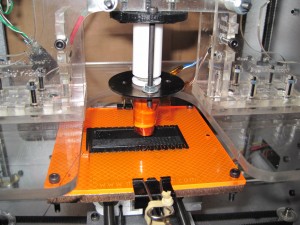There really is something special about having built this robot for myself. I know it pretty well how it works and why certain design and engineering decisions were made.
I’ve also modified and customized this robot as I’ve used it. I’ve moved the extruder board, rotated the motherboard to give me better access to the SD card, drilled a few holes in the sides, yanked out the opto-endstops, extended the wires running to the extruder motor, thermistor, and nichrome. I’ve even designed a few minor printable upgrades.
When my extruder stopped working (twice) I just took it apart. I know I’m not going to break it as I do so. And, hell, if I do break it I’ll just fix it.
Drafts Zero - The Lost Blog Posts- The Lost Blog Posts
- Plastruder! [Draft 12/25/2009]
- UNTITLED [Draft 12/25/2009]
- Preparing to print [Draft 12/27/2009]
- More prints [Draft 01/04/2010]
- Prototype Pricing [Draft 01/19/2010]
- MakerBot tuning [Draft 01/20/2010]
- Plastic Screw Anchor [Draft 02/02/2010]
- Magic [Draft 02/03/2010]
- How are you printing with PLA? [Draft 02/16/2010]
- Rebuilding my extruder [Draft 02/16/2010]
- MY robot [Draft 02/18/2010]
- more things i learned [Draft 02/20/2010]
- First commissioned piece! [Draft 02/22/2010]
- MakerBot: Toy or Tool? [02/25/2010]
- Idea for Skeinforge settings… [Draft 03/27/2010]
- RepRap and MakerBot alternatives [Draft 04/05/2010]
- RepRap Parts for Sale [Draft 04/07/2010]
- Where is the Othercutter? [Draft 06/08/2015]

